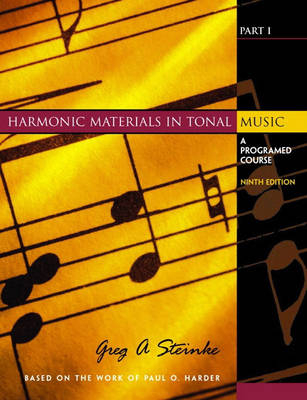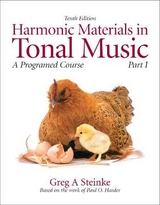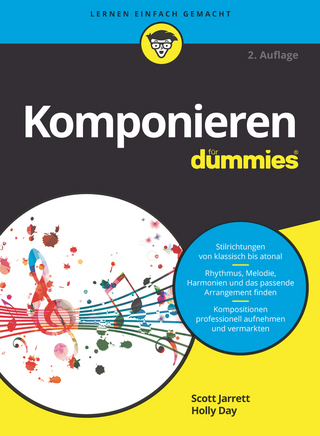
Harmonic Materials in Tonal Music
Pearson (Verlag)
978-0-13-091073-8 (ISBN)
- Titel erscheint in neuer Auflage
- Artikel merken
Created for introductory courses in basic music theory and harmonic practice, this self-paced, auto-instructional text in two volumes has become a “classic” in the field. Since the students work independently through the programmed format of the text, instructors can concentrate on the more creative aspects of their course. From the wealth of clearly laid-out lessons and exercises, students receive continual feedback and reinforcement as they work through the sequence at their own pace. Also, a set of musical examples on compact discs accompanies the volumes, providing students with aural experience of tonal and harmonic material used in the text. Neither books nor CDs can be ordered alone. See below for ordering code.
Dr. Paul O. Harder (1923-1986) received a Master of Music degree in Music Theory from the Eastman School of Music, University of Rochester, where he performed as oboist with the Rochester Philharmonic Orchestra. Later, as a fellowship student at the University of Iowa, he received his Ph.D. in Music Composition. He studied composition with Mlle. Nadia Boulanger at the École des Beaux Arts de Fountainbleau, France, sand at the Royal Academy of Music in Copenhagen, Denmark. Dr. Harder held the post of Chairman of Music Theory at Michigan State University before becoming Assistant Vice President and Professor of Music at California State University, Stanislaus. He was a Professor Emeritus at Michigan State University. In addition to approximately fifty compositions for a variety of media including orchestra, band, chorus, and chamber groups, Dr. Harder was the author of Harmonic Materials in Tonal Music, Parts I and II, through the fifth edition; Basic Materials in Music Theory, through the sixth edition; Music Manuscript Techniques, Parts I and II; and Bridge to Twentieth Century Music, through the first edition. Dr. Greg A Steinke (b. 1942) holds a Bachelor of Music degree from Oberlin Conservatory, a Master of Music degree from Michigan State University, a Master of Fine Arts degree from the University of Iowa, and a Doctor of Philosophy degree from Michigan State University. Dr. Steinke retired in June 2001 as Chair of the Art and Music Departments, Associate Dean for Undergraduate Studies, and holder of the Joseph Naumes Endowed Chair in Music at Marylhurst University in Oregon. Formerly, he was Dean of the College of Fine Arts and Professor of Music at Millikin University, Director of the School of Music and Professor of Music at Ball State University, Assistant Director of the School of Music at the University of Arizona, Chairman of the Music Department at San Diego State University, Director of the School of Music at the University of Idaho, Chairman of the Music Department at Linfield College, and a faculty member at Northern Arizona University, The Evergreen State College, California State University, Northridge, and the University of Maryland. Currently, he is a freelance composer, writer, oboist, and conductor. Dr. Steinke is the author of numerous articles, has done the revisions to Paul Harder's Basic Materials in Music Theory (seventh through tenth editions), Harmonic Materials in Tonal Music (sixth through ninth editions), and Bridge to Twentieth Century Music (revised edition). He holds membership in a number of professional organizations and served for nine years (three terms) 1988-97 as the President and National Chairman of the Society of Composers, Inc. Professor Steinke is active as a composer of chamber and symphonic music with a number of published works, as a speaker on interdisciplinary .arts, and as an oboe soloist specializing in contemporary music.
Part I:
1. Some Definitions.
2. The Structure of Tonality.
3. Triads in Root Position: Doubling and Spacing.
4. Triads in Root Position: Voice Leading.
5. Triads in First and Second Inversion.
6. Introduction to Seventh Chords and the Dominant Seventh.
7. Phrase Structure and Cadences.
8. Nonharmonic Tones.
9. Harmonic Progression.
10. The Technique of Harmonization.
Appendix A: Chord Symbols.
Appendix B: Piano Styles.
Appendix C: Glossary of Terms.
Appendix D: Orchestration Chart.
Bibliography for Further Study.
Index of Musical Examples.
Subject Index.
About the Author.
Part II:
1. A Review of Seventh Chords and the Dominant Seventh.
2. Nondominant Seventh Chords.
3. Altered Nonharmonic Tones and Secondary Dominants.
4. Modulation to Closely Related Keys.
5. Borrowed Chords.
6. Augmented Sixth Chords.
7. The Neapolitan Sixth, Altered Dominants, and Diminished Seventh Chords.
8. Chromatic Third-Relation Harmony.
9. Modulation to Foreign Keys: Part 1.
10. Modulation to Foreign Keys: Part 2.
11. Ninth, Eleventh, and Thirteenth Chords.
Appendix A: Chord Symbols.
Appendix B: Piano Styles.
Appendix C: Glossary of Terms.
Appendix D: Orchestration Chart.
Bibliography for Further Study.
Index of Musical Examples.
Subject Index.
About the Author.
| Erscheint lt. Verlag | 6.9.2001 |
|---|---|
| Sprache | englisch |
| Maße | 216 x 279 mm |
| Themenwelt | Kunst / Musik / Theater ► Musik |
| ISBN-10 | 0-13-091073-2 / 0130910732 |
| ISBN-13 | 978-0-13-091073-8 / 9780130910738 |
| Zustand | Neuware |
| Haben Sie eine Frage zum Produkt? |
aus dem Bereich



